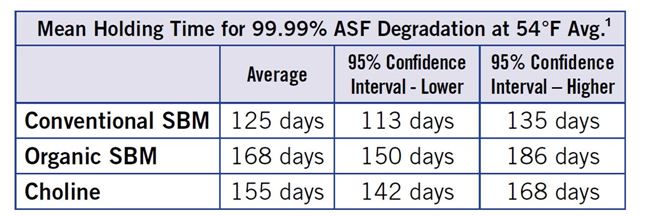How Long Does African Swine Fever Live in Feed?
Farm Journal Pork 021220
The science on viral transmission through feed and feedstuffs is relatively young, but research in the past year has yielded some interesting and useful information. New research improves upon current understanding of how the deadly African swine fever (ASF) virus survives in feed. Research shows it lasts much longer than scientists originally thought.
Earlier studies evaluated the half-life of Senecavirus A (SVA). The half-life is the amount of time that it takes for half of a virus that may be contaminating feed or a feed ingredient to die off naturally.
“We wanted to get information as quickly as we could and make it as best as possible so we chose Senecavirus A because it's not a regulatory virus and you don't need a high biosecurity lab to do the work,” explains Paul Sundberg, DVM, executive director of the Swine Health Information Center (SHIC).
SVA is in the same family that’s closely related to foot-and-mouth disease (FMD), he explains. Because FMD is very resistant and lives a long time in the environment, researchers thought SVA would be similar and likely be one of the hardier viruses that could be tested quickly.
“The bottom line is that we thought the initial research with SVA would be good,” Sundberg says. “But we tested it and learned that ASF lasts even longer than SVA, so we want people to know and be able to factor this information into their decision process. If our focus is on ASF right now (and that’s appropriate), we need to make sure people are aware of the research that directly works with ASF.”
Survivability of ASF in feed
The initial research providing the best understanding of viral survivability in feedstuffs and details for mitigating risk to domestic herds via holding times, based on using SVA in the model, was funded by SHIC and the Institute for Feed Education and Research, the public charity of the American Feed Industry Association, a SHIC release said.
The initial estimations, calculated in October 2018 then updated in May 2019, now reflect new information from recent work done on African swine fever (ASF) half-life by Megan Niederwerder, assistant professor of diagnostic medicine and pathobiology in the College of Veterinary Medicine, and her team at Kansas State University.
Based on the conditions of transoceanic shipment needed to import into the U.S., the following table displays the mean holding times calculated to provide 99.99% ASF degradation at 54 degrees F (average).
Source: SHIC
What can producers do?
Feed component holding times is one tool that can be used in conjunction with other mitigations to enhance feed safety. Sourcing feed components from regions or countries of the world that don’t have ASF, or other diseases foreign to the U.S., also negates potential risk.
“We have to be really careful about what we do with recommendations. Half-life and holding time are just one thing for producers to consider. They are tools, but probably not the complete answer,” Sundberg says.
Regarding soybean meal, the new holding time may be so long that it’s unattainable and not implementable.
“One thing you can do to enhance feed safety is to ask where your supplier gets their supplies from,” he says. “With soybean meal that we now know needs to be held for a long period of time, you may consider telling your feed supplier that you want soybean meal sourced from countries or areas of world that don’t have ASF.”
SHIC, the National Pork Board, the National Pork Producers Council, and the American Association of Swine Veterinarians are continuing to offer updated and revised information for feed holding times to mitigate virus transmission.
Complete information on the research leading to the holding time calculation is posted on the SHIC website. SHIC also provides information on questions producers should be asking their feed suppliers as part of their biosecurity protocol.
More from Farm Journal's PORK:
Reduce the Risk of African Swine Fever Virus Transmission in Feed
K-State Confirms Possible Danger of Imported ASF-Contaminated Feed
Research: Hog Cholera and Pseudorabies Could Spread Through Feed








